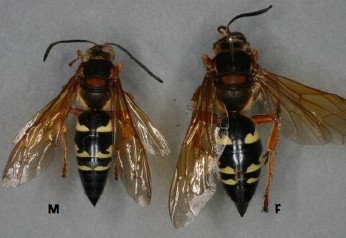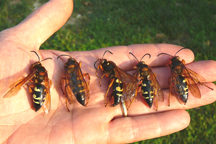|
Cicada Killer
Cicada killer wasps (genus ''Sphecius'') are large, solitary, ground-dwelling, predatory wasps. They are so named because they hunt cicadas and provision their nests with them, after stinging and paralyzing them. Twenty-one species worldwide are recognized. The highest diversity occurs in the region between North Africa and Central Asia. In North America, the term "cicada killer wasp" usually refers to the most well-known species, the eastern cicada killer (''S. speciosus''). A few other related genera also are sometimes referred to as "cicada killers", e.g. ''Liogorytes'' in South America and ''Exeirus'' in Australia. The use of cicadas as prey is in keeping with the typical behavior of the tribe Gorytini, which tend to specialize on various members of the Cicadomorpha as prey items. Species This list of species is probably complete as of March 31, 2009. It has been adapted from thCatalog of ''Sphecius'' species(California Academy of Sciences). Notable subspecies are also g ... [...More Info...] [...Related Items...] OR: [Wikipedia] [Google] [Baidu] |
Sphecius Grandis
''Sphecius grandis'', also called the western cicada killer, is a species of cicada killer wasp (''Sphecius''). The western species shares the same nesting biology as its fellow species, the eastern cicada killer ('' S. speciosus''). ''S. grandis'', like all other species of the genus ''Sphecius'', mainly provides cicadas for its offspring. It forms nest aggregations and mates and broods once in a year, in July and early August. The wasp is on average to in length and is amber-yellow with yellow rings on its abdomen. Wasps in the genus ''Sphecius'' are not habitually aggressive and use their venom mainly to paralyse cicadas which they take back to their nests to feed their young. The females catch around four or more cicadas for provisioning, place them in brood cells and lay eggs in the cells. ''S. grandis'' is endemic to Central America, Mexico and the Western United States, and is found at a higher mean altitude than other species of ''Sphecius''. The western ci ... [...More Info...] [...Related Items...] OR: [Wikipedia] [Google] [Baidu] |
Sphecius Speciosus
''Sphecius speciosus'', often simply referred to as the cicada killer or the cicada hawk, is a large, solitary digger wasp species in the family Crabronidae. The name may be applied to any species of crabronid that preys on cicadas, though in North America, it is typically applied to this species, also referred to as the eastern cicada killer in order to further differentiate it from the multiple other examples of related wasp species. Sometimes, they are called sand hornets, although they are not hornets, which belong to the family Vespidae. This species can be found in the Eastern and Midwest U.S. and southwards into Mexico and Central America. They are so named because they hunt cicadas and provision their nests with them. Cicada killers exert a measure of natural control on cicada populations, and as such they may directly benefit the deciduous trees upon which the cicadas feed. The most recent review of this species' biology is found in the posthumously published comprehens ... [...More Info...] [...Related Items...] OR: [Wikipedia] [Google] [Baidu] |
Sphecius Hemixanthopterus
Cicada killer wasps (genus ''Sphecius'') are large, solitary, ground-dwelling, predatory wasps. They are so named because they hunt cicadas and provision their nests with them, after stinging and paralyzing them. Twenty-one species worldwide are recognized. The highest diversity occurs in the region between North Africa and Central Asia. In North America, the term "cicada killer wasp" usually refers to the most well-known species, the eastern cicada killer (''S. speciosus''). A few other related genera also are sometimes referred to as "cicada killers", e.g. '' Liogorytes'' in South America and '' Exeirus'' in Australia. The use of cicadas as prey is in keeping with the typical behavior of the tribe Gorytini, which tend to specialize on various members of the Cicadomorpha as prey items. Species This list of species is probably complete as of March 31, 2009. It has been adapted from thCatalog of ''Sphecius'' species(California Academy of Sciences). Notable subspecies are also ... [...More Info...] [...Related Items...] OR: [Wikipedia] [Google] [Baidu] |
Eastern Cicada Killer
''Sphecius speciosus'', often simply referred to as the cicada killer or the cicada hawk, is a large, solitary digger wasp species in the family Crabronidae. The name may be applied to any species of crabronid that preys on cicadas, though in North America, it is typically applied to this species, also referred to as the eastern cicada killer in order to further differentiate it from the multiple other examples of related wasp species. Sometimes, they are called sand hornets, although they are not hornets, which belong to the family Vespidae. This species can be found in the Eastern and Midwest U.S. and southwards into Mexico and Central America. They are so named because they hunt cicadas and provision their nests with them. Cicada killers exert a measure of natural control on cicada populations, and as such they may directly benefit the deciduous trees upon which the cicadas feed. The most recent review of this species' biology is found in the posthumously published comprehens ... [...More Info...] [...Related Items...] OR: [Wikipedia] [Google] [Baidu] |
Zootaxa
''Zootaxa'' is a peer-reviewed scientific mega journal for animal taxonomists. It is published by Magnolia Press ''Magnolia'' is a large genus of about 210 to 340The number of species in the genus ''Magnolia'' depends on the taxonomic view that one takes up. Recent molecular and morphological research shows that former genera ''Talauma'', ''Dugandiodendr ... (Auckland, New Zealand). The journal was established by Zhi-Qiang Zhang in 2001 and new issues are published multiple times a week. From 2001 to 2020, more than 60,000 new species have been described in the journal accounting for around 25% of all new Taxon, taxa indexed in The Zoological Record in the last few years. Print and online versions are available. Temporary suspension from JCR The journal exhibited high levels of self-citation and its journal impact factor of 2019 was suspended from ''Journal Citation Reports'' in 2020, a sanction which hit 34 journals in total. Biologist Ross Mounce noted that high levels of ... [...More Info...] [...Related Items...] OR: [Wikipedia] [Google] [Baidu] |
Reproductive Isolation
The mechanisms of reproductive isolation are a collection of evolutionary mechanisms, behaviors and physiological processes critical for speciation. They prevent members of different species from producing offspring, or ensure that any offspring are sterile. These barriers maintain the integrity of a species by reducing gene flow between related species.Strickberger, M. 1978. ''Genética''. Omega, Barcelona, España, p.: 874-879. .Futuyma, D. 1998. ''Evolutionary biology'' (3ª edición). Sinauer, Sunderland. The mechanisms of reproductive isolation have been classified in a number of ways. Zoologist Ernst Mayr classified the mechanisms of reproductive isolation in two broad categories: pre-zygotic for those that act before fertilization (or before mating in the case of animals) and post-zygotic for those that act after it.Mayr, E. 1963. ''Animal species and evolution''. Harvard University Press, Cambridge. The mechanisms are genetically controlled and can appear in species who ... [...More Info...] [...Related Items...] OR: [Wikipedia] [Google] [Baidu] |
.jpg)


_with_Cicada.jpg)
